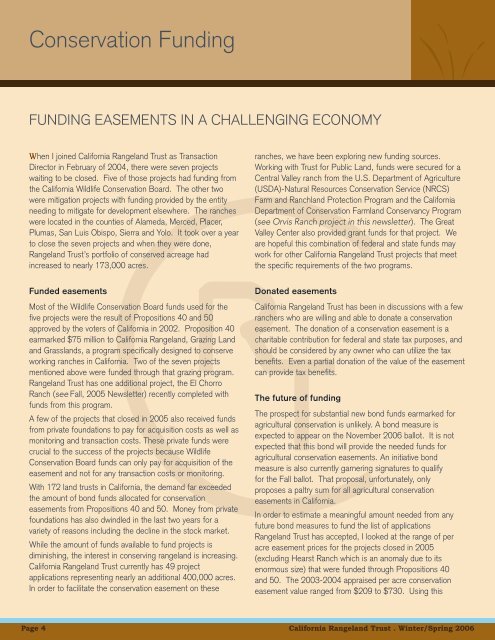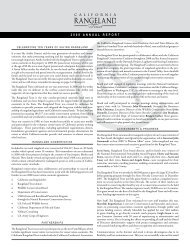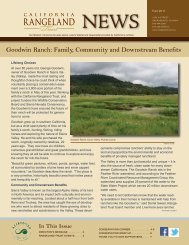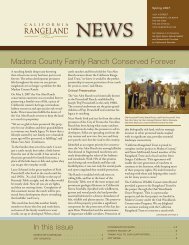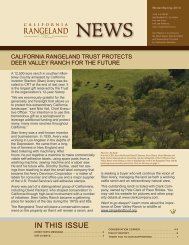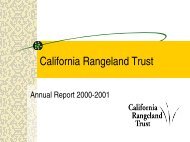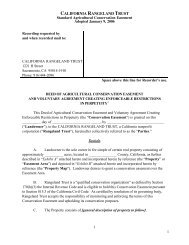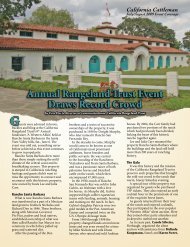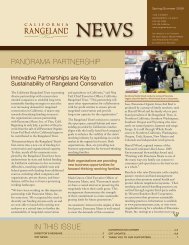CRT - Summer 2006 Newsletter - The California Rangeland Trust
CRT - Summer 2006 Newsletter - The California Rangeland Trust
CRT - Summer 2006 Newsletter - The California Rangeland Trust
You also want an ePaper? Increase the reach of your titles
YUMPU automatically turns print PDFs into web optimized ePapers that Google loves.
Conservation Funding<br />
FUNDING EASEMENTS IN A CHALLENGING ECONOMY<br />
When I joined <strong>California</strong> <strong>Rangeland</strong> <strong>Trust</strong> as Transaction<br />
Director in February of 2004, there were seven projects<br />
waiting to be closed. Five of those projects had funding from<br />
the <strong>California</strong> Wildlife Conservation Board. <strong>The</strong> other two<br />
were mitigation projects with funding provided by the entity<br />
needing to mitigate for development elsewhere. <strong>The</strong> ranches<br />
were located in the counties of Alameda, Merced, Placer,<br />
Plumas, San Luis Obispo, Sierra and Yolo. It took over a year<br />
to close the seven projects and when they were done,<br />
<strong>Rangeland</strong> <strong>Trust</strong>’s portfolio of conserved acreage had<br />
increased to nearly 173,000 acres.<br />
ranches, we have been exploring new funding sources.<br />
Working with <strong>Trust</strong> for Public Land, funds were secured for a<br />
Central Valley ranch from the U.S. Department of Agriculture<br />
(USDA)-Natural Resources Conservation Service (NRCS)<br />
Farm and Ranchland Protection Program and the <strong>California</strong><br />
Department of Conservation Farmland Conservancy Program<br />
(see Orvis Ranch project in this newsletter). <strong>The</strong> Great<br />
Valley Center also provided grant funds for that project. We<br />
are hopeful this combination of federal and state funds may<br />
work for other <strong>California</strong> <strong>Rangeland</strong> <strong>Trust</strong> projects that meet<br />
the specific requirements of the two programs.<br />
Funded easements<br />
Most of the Wildlife Conservation Board funds used for the<br />
five projects were the result of Propositions 40 and 50<br />
approved by the voters of <strong>California</strong> in 2002. Proposition 40<br />
earmarked $75 million to <strong>California</strong> <strong>Rangeland</strong>, Grazing Land<br />
and Grasslands, a program specifically designed to conserve<br />
working ranches in <strong>California</strong>. Two of the seven projects<br />
mentioned above were funded through that grazing program.<br />
<strong>Rangeland</strong> <strong>Trust</strong> has one additional project, the El Chorro<br />
Ranch (see Fall, 2005 <strong>Newsletter</strong>) recently completed with<br />
funds from this program.<br />
A few of the projects that closed in 2005 also received funds<br />
from private foundations to pay for acquisition costs as well as<br />
monitoring and transaction costs. <strong>The</strong>se private funds were<br />
crucial to the success of the projects because Wildlife<br />
Conservation Board funds can only pay for acquisition of the<br />
easement and not for any transaction costs or monitoring.<br />
With 172 land trusts in <strong>California</strong>, the demand far exceeded<br />
the amount of bond funds allocated for conservation<br />
easements from Propositions 40 and 50. Money from private<br />
foundations has also dwindled in the last two years for a<br />
variety of reasons including the decline in the stock market.<br />
While the amount of funds available to fund projects is<br />
diminishing, the interest in conserving rangeland is increasing.<br />
<strong>California</strong> <strong>Rangeland</strong> <strong>Trust</strong> currently has 49 project<br />
applications representing nearly an additional 400,000 acres.<br />
In order to facilitate the conservation easement on these<br />
Donated easements<br />
<strong>California</strong> <strong>Rangeland</strong> <strong>Trust</strong> has been in discussions with a few<br />
ranchers who are willing and able to donate a conservation<br />
easement. <strong>The</strong> donation of a conservation easement is a<br />
charitable contribution for federal and state tax purposes, and<br />
should be considered by any owner who can utilize the tax<br />
benefits. Even a partial donation of the value of the easement<br />
can provide tax benefits.<br />
<strong>The</strong> future of funding<br />
<strong>The</strong> prospect for substantial new bond funds earmarked for<br />
agricultural conservation is unlikely. A bond measure is<br />
expected to appear on the November <strong>2006</strong> ballot. It is not<br />
expected that this bond will provide the needed funds for<br />
agricultural conservation easements. An initiative bond<br />
measure is also currently garnering signatures to qualify<br />
for the Fall ballot. That proposal, unfortunately, only<br />
proposes a paltry sum for all agricultural conservation<br />
easements in <strong>California</strong>.<br />
In order to estimate a meaningful amount needed from any<br />
future bond measures to fund the list of applications<br />
<strong>Rangeland</strong> <strong>Trust</strong> has accepted, I looked at the range of per<br />
acre easement prices for the projects closed in 2005<br />
(excluding Hearst Ranch which is an anomaly due to its<br />
enormous size) that were funded through Propositions 40<br />
and 50. <strong>The</strong> 2003-2004 appraised per acre conservation<br />
easement value ranged from $209 to $730. Using this<br />
Page 4<br />
<strong>California</strong> <strong>Rangeland</strong> <strong>Trust</strong> . Winter/Spring <strong>2006</strong>


